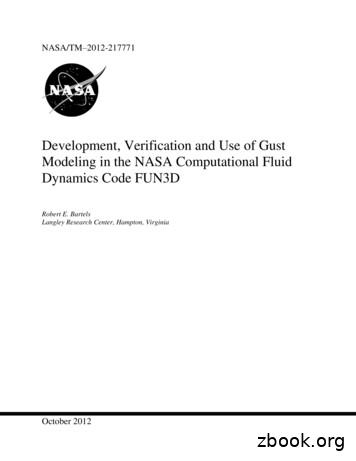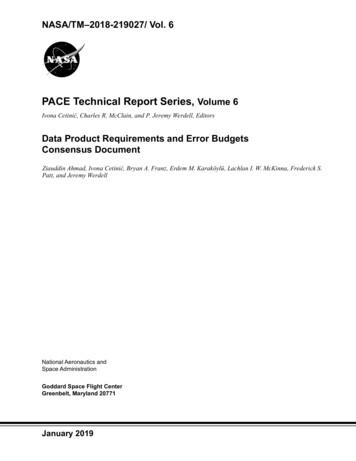Project Goals - NASA
6/16/2011National Aeronautics and Space Administration (NASA)Gas Dynamic SprayTechnology Demonstration AFSPC Corrosion Prevention AdvisoryBoard MeetingJune 2011NASA Technology Evaluation for EnvironmentalRisk Mitigation Principal Center (TEERM)Pattie Lewis Burford, ITBKennedy Space Centerhttp://www.nasa.govNational Aeronautics and Space Administration (NASA)Project GoalsValidate Gas Dynamic Spray as a means ofrepairing Thermal Spray Coatings Zinc primer systems are currently used across NASA and AFSPCfor corrosion protection of steel. AFSPC and NASA have approved the use of Thermal SprayCoatings (TSCs) as an environmentally preferable alternative. TSCs are approved in NASA-STD-5008 and AFSPC and KSC iscurrently looking for additional applications in which TSC can beused. Gas Dynamic Spray (GDS, also known as Cold Spray) is beingevaluated as a means of repairing TSCs and for areas such ascorners and edges where TSCs do not work as well. Other applications could include spot repair/maintenance of steelon structures, facilities, and ground support equipment.21
6/16/2011National Aeronautics and Space Administration (NASA)DescriptionStakeholders: Kennedy Space Center (KSC), Cape Canaveral Air ForceStation (CCAFS), Patrick Air Force Base (PAFB) , and Air ForceSpace Command (AFSPC)Project Set-up: 18-Month Marine Exposure at KSC Beach Corrosion Test Site*Also tested at CCAFS SLC 17Aas part of Launch Coatings Ph 2ProjectNational Aeronautics and Space Administration (NASA)Project Justification Eliminates risk associated with environmental, safety, and healthconcerns associated with volatile organic compounds (VOCs),hazardous air pollutants (HAPs), isocyanates, and otherhazardous materials. Reduced material obsolescence risks. Low temperature spray reduces oxidation, vaporization, andresidual stresses associated with traditional thermal spray orwelding processes. Sprayed material is machinable and corrosion-resistant. Finished materials have high densities and high electrical andthermal conductivities. Material can build up to as much as one inch. Findings applicable to both NASA and AFSPC2
6/16/2011National Aeronautics and Space Administration (NASA)Technical Analysis Current (baseline) Coating Process - Identified in NASA-STD-500B Inorganic zinc primer Intermediate coating Isocyanate-containing polyurethane topcoat- Strengths Excellent corrosion protection Excellent gloss and color retention- Weaknesses Contains isocyanates, high VOC content, HAPs, andother hazardous materials Material obsolescence risksNational Aeronautics and Space Administration (NASA)Technical Analysis Alternative Coating Systems5 - TSCs Strengths-Zero VOCs-Zero HAPs- Zero isocyanates- Excellent corrosion and heat resistance- Can last up to 20 years Weaknesses- Bulky, hard to maneuver equipment-Ineffective in corners and on edges- Expensive equipment and coating materials63
6/16/2011 National Aeronautics and Space Administration (NASA)Technical Analysis Alternative Coati ng SystemsGDS Coatings Strengths- Zero VOCs, HAPs, and isocyanates- Able to be used on edges and in corners- Equipment smaller and more portable than TSCequipment- Equipment can also perform surface preparation Weaknesses- Costs of equipment and materials- Speed of coating application7National Aeronautics and Space Administration (NASA)ApproachSubstrates and Coatings of Interest Substrates:- A36 Carbon Steel- 6061-T6 Aluminum alloy- 5052-H32 Aluminum alloy Base/Repair Coatings:-Zinc (Zn) TSCAluminum-Magnesium (AI-Mg) TSCZn GDS coatingZinc-Aluminum (Zn-AI) GDS coatingAluminum (AI) GDS coating Liquid Topcoat- Carboline Carbothane 133MC84
.6/16/2011 National Aeronautics and Space Administration (NASA)ApproachThe following test panels were decided upon: Flat panel, undamaged-to provide baseline data Flat panel, damaged- to simulate damaged and repairedcoatings Composite panel-to simulate corners and edgesFlatUndamagedFlatDamagedComposite(Steel only)9 National Aeronautics and Space Administration (NASA)Approach Scribed Panelst/ScribedScribed-GOS RepairedScribed-Topcoate'ld5
6/16/2011 National Aeronautics and Space Administration (NASA)ApproachPhase 1 Coupon MatrixSubstrateBase CoatCouponI Repair Coat I Topcoat.,,,,,,,, Undamaged ,,,,,,,,,,,,,,,,,,,NA,.,,ZnGDSDamagedA36 oneZnGDS,,,,,, UndamagedNAYesNoYesNoYesNoYesNoYesNoYesNo1 National Aeronautics and Space Administration (NASA)Progress Equipment purchased and delivered. Final Joint Test Plan completed and approved bystakehol ders. Preparation for testing completed (Jul 09). Test panels places at KSC Corrosion Test Site (Aug09). Conducted Heat Adhesion Testing andevaluation (Feb 10).6-month Conducted 12-month evaluation (Aug 10). Conducted 18-month evaluation (Feb 11). Draft test report distributed to stakeholders (Jun 11 6-'
6/16/2011National Aeronautics and Space Administration (NASA) 13National Aeronautics and Space Administration (NASA)147
6/16/2011National Aeronautics and Space Administration (NASA)OFT Measurements for Flat 854961037CoatingZnTSCZnTSCZnTSCZnTSCZn TSC 133MCZn TSC 133MCZn TSC 133MCZn TSC 133MCZn TSC - scribedZn TSC - scribedZn TSC - scribedZn TSC - scribedZn TSC (scribed) 133MCZn TSC (scribed) 133MCZn TSC (scribed) 133MCZn TSC (scribed) 133MCZn TSC (scribed) GDS'Zn TSC (scribed) GDS'Zn TSC (scribed) GDS'Zn TSC (scribed) GDS'Zn TSC GDS' 133MCZn TSC GDS' 133MCZn TSC GDS' 133MCZn TSC GDS' .518.013.8Topcoat 0NIAN/AN/AN/A7.27.17.47.4National Aeronautics and Space Administration (NASA)OFT Measurements for Composite SCZnTSCZnTSCZnTSCZn TSC 133MCZn TSC 133MCZn TSC 133MCZn TSC 133MCZn TSC GDS'Zn TSC GDS'Zn TSC GDS'ZnTSC GDS'TSC GDS' 133MCTSC GDS' 133MCTSC GDS' 133MCTSC GDS' 133MCZn GDSZn GDSZn GDSZnGDSZn GDS 133MCZn GDS 133MCZn GDS 133MCZn GDS .66.7Topcoat 3N/AN/ANIAN/A10011.311.011.1 Avg Panel 2 Avg Panel 8
6/16/2011National Aeronautics and Space Administration (NASA)Test Rack 1 LayoutZnTSC GDS 133MCZnTSC GDS 133MCZnTSC GDS 133MCZnTSC GDS 133MCZnTSC GDSZnTSC GDSZnTSC GDSZnTSC GDSZnTSC 133MCZnTSC 133MCZnTSC 133MCZnTSC 133MCZnTSC 133MCZnTSC 133MCZnTSC 133MCZnTSC 133MC National Aeronautics and Space Administration (NASA)Test Rack 1 Photos0'.en.cGl!:!:. iii 0Ol::;,.·c.c:III0:i:en 9
6/16/2011National Aeronautics and Space Administration (NASA)Test Rack 1 Photos 0'.-.Cl::s.c Ql.Ul!:.r::: . Ul0r:::::E0I::EN.ri:J.National Aeronautics and Space Administration (NASA)Test Rack 2 LayoutZnGDS 133MCZnGDS 133MCZnGDS 133MCZn GDS 133MCZnTSC GDS 133MCZnTSC GDS 133MCZnTSC GDS 133MCZnTSC GDS 133MCZnTSC GDSZnTSC GDSZnTSC GDSZnTSC GDSZnTSC 133MCZnTSC 133MCZnTSC 133MCZnTSC 133MC 10
6/16/2011National Aeronautics and Space Administration (NASA)Test Rack 2 Photos 0.cCIILL.(;)0Cl-.c::C;;;;0 .r:::UI::s :E enNational Aeronautics and Space Administration (NASA)Test Rack 2 Photos.0Cl::s UI.c::r:::.0 .N -.cCII!:!:. .c::.UIr:::0 I.(II)11
6/16/2011 National Aeronautics and Space Administration (NASA)Deg ree of Rusti ngRust Ratings after 18 Months per ASTM 0610SSPC·V1S 2 "Gil RatingsSystemPanel TypeZnTSCPanel Panel Panel PanelAvg.1234Flat1010101010.0Zn TSC 133 MCFlat1010101010.0ZnTSCComposite9910109.5Zn TSC 133 MCComposite10101099.8Zn TSC GOS·Composite109899.0Zn TSC GOS· 133 MCComposite1010101010.0ZnGOSComposite99988.8Zn GOS 133 MCComposite1010101010.023 National Aeronautics and Space Administration (NASA)ZnTSC:rr. .-.:.',.'\. .bl·:jt:·· 101010'I'.' -l;., . .,. .:'102412
6/16/2011 National Aeronautics and Space Administration (NASA)Zn TSC 133MC10101010 National Aeronautics and Space Administration (NASA)ZnTSC10101025102613
6/16/2011National Aeronautics and Space Administration (NASA)ZnTSC /.10 1010/10Zn TSC Zn GOS101027 National Aeronautics and Space Administration (NASA)10 102814
6/16/2011 National Aeronautics and Space Administration (NASA)Zn TSC Zn GOS 133MC10101010 National Aeronautics and Space Administration (NASA)ZnTSC,·r-.r.29. l. .J; . .,.,9910103015
6/16/2011 National Aeronautics and Space Administration (NASA)Zn TSC 133MC1010101031National Aeronautics and Space Administration (NASA)Zn TSC Zn GOS109893216
.6/16/2011 National Aeronautics and Space Administration (NASA)Zn TSC Zn GOS 133MC10101010 National Aeronautics and Space Administration (NASA)ZnGOS9893393417
6/16/2011 National Aeronautics and Space Administration (NASA)Zn GOS 133MC1010101035 National Aeronautics and Space Administration (NASA)Scribe RatingsScribe Ratings after 18 Months per ASTM 0 1654SSPC·VIS 2 "G" RatingsPanel Panel Panel PanelAvg.4123SystemPanel TypeZnTSCFlat1010101010.0Zn TSC 133 MCFlat1010999.5Zn TSC GOS·Flat1010101010.0Zn TSC GOS· 133 MCFlat1010101010.0Blister Ratings Blister ratings per ASTM 0714. After 18 months, no panels exhibited blistering and all rated a10-None.3618.
.6/16/2011National Aeronautics and Space Administration (NASA)Gloss MeasurementsGloss Retention Results per ASTM 0 , 122, 125, 5%The GDS had a smoother finish and therefore a slightly higher gloss. Bothsystems, however, maintained over 90% of gloss after 18 months exposure.37 National Aeronautics and Space.Administration (NASA)Color MeasurementsColor Retention Results per ASTM 0 2244InitialPanelsPrimer17,122,ZnTSC125, eLa18-MonthbLabDe/mEFlat94.49 -0.682.6995.14 -2.647.555.3Comp94.74 -0.712.8195.61-1.295.522.9Comp94.642.895.58 -1.846.854.3-0.7As a general rule, a delta E value of one (1) would be discernable by thehuman eye in a side by side comparison. However, in less than ideal lighting,a delta E value of two (2) or three (3) can still be considered the same color.3819
6/16/2011National Aeronautics and Space Administration (NASA)Adhesion Testing NASA-STD-5008 requires zinc primer coatings have atemperature resistance of 400 C (750 F). Tested by exposing panels in an oven to a temperature of400 C for 24 hours. Any visual deterioration, such as destruction or burning of thecoating, would establish failure of the product. Loss of adhesion (per ASTM 0 4541) also constitutes afailure due to temperature effects on the film. Comparisons are made pre- and post-heat exposure. Since TSC are considered replacements for zinc primers,they were tested to this requirement. GDS was also tested.39National Aeronautics and Space Administration (NASA)Adhesion Testing Results As applied, the Zn GDS adhesion values (2625 psi) initiallyaveraged over three (3) times the adhesive strength of theZn TSC (780 psi).- Both the Zn GDS and Zn TSC meet the minimumadhesion criteria of 500 psi found in SSPC-CS 23.00. The post-heat Zn TSC showed a 42% increase in tensileadhesion after heating. The Zn GDS, however, lost 88% of its adhesive strength andfailed to meet the minimum adhesion values stated inSSPC-CS 23.00.4020.
'. ,6/16/2011National Aeronautics and Space Administration (NASA)Adhesion Testing Results Tablepre tmg preheat psiCoatinga\9dftpsimTSC1 12mils740mlSC1 12 mils860mTSCmISC1 12 mils1 12milsFailureModepost-heat t a\9 postpsiheat psi cohesi\e739cohesi\e946cohesi\emOOS 8-10 mils2512cohesi\e492zinc splitmOOS 8-10 mils2018cohesi\e294mGDS 8-10 mils3131cohesi\e336zinc splitmOOS 8-10 mils2840cohesi\e117zinc split7802625cohesi\e1111310cohesi\ezinc split heated to 750F i: r 24 hours and cooled to room temperature before re-testing41National Aeronautics and Space Administration (NASA)Adhesion Testing ResultsZn TSC Panels Zn GDS PanelsThe manufacturer of the GDS unit (Centerline) was contacted to discusswhy the dramatic drop in adhesion may have occurred. It is believed thatthere was a weak Zn particle/particle boundary (due to a lack of diffusionbonding). This allowed oxygen to find open diffusion paths during the42heating phase and led to oxidation within the layers of the coating.21
. ., . .
6 Zn TSC GDS' 133MC 11.9 7.2 19.1 10 Zn TSC GDS' 133MC 18.5 7.1 25.6 3 Zn TSC GDS' 133MC 18.0 7.4 25.4 15 7 Zn TSC GDS' 133MC 13.8 7.4 21.2 National Aeronautics and Space Administration (NASA) OFT Measurements for Composite Panels Panel Coating PrlmerOFT Topcoat OFT Avg PanelOFT 237 ZnTSC 17.1
2016 nasa 0 29 nasa-std-8739.4 rev a cha workmanship standard for crimping, interconnecting cables, harnesses, and wiring 2016 nasa 0 30 nasa-hdbk-4008 w/chg 1 programmable logic devices (pld) handbook 2016 nasa 0 31 nasa-std-6016 rev a standard materials and processes requirements for spacecraft 2016 nasa 0 32
Jan 10, 2012 · The NASA STI program provides access to the NASA Aeronautics and Space Database and its public interface, the NASA Technical Report Server, thus providing one of the largest collections of aeronautical and space science STI in the world. Results are published in both non-NASA channels and by NASA in the NASA
The NASA STI program provides access to the NASA Aeronautics and Space Database and its public interface, the NASA Technical Report Server, thus providing one of the largest collections of aero-nautical and space science STI in the world. Results are published in both non-NASA channels and by NASA in the NASA
The NASA STI program provides access to the NASA Aeronautics and Space Database and its public interface, the NASA Technical Report Server, thus providing one of the largest collections of aero-nautical and space science STI in the world. Results are published in both non-NASA channels and by NASA in the NASA STI Report Series, which includes
The NASA STI program provides access to the NASA Aeronautics and Space Database and its public interface, the NASA Technical Report Server, thus providing one of the largest collections of aero-nautical and space science STI in the world. Results are published in both non-NASA channels and by NASA in the NASA STI Report Series, which includes
research goals into discrete and measurable evaluation criteria for use in the DSR processes. This position paper proposes an inclusive approach for articulating DSR goals and then identi- fying project evaluation criteria for these goals. The goals are organized hierarchically as utilitarian goals, safety goals, interaction and communication goals, cognitive and aesthetic goals, innovation .
This is a tool developed to help NASA Project managers to understand NASA NPD and NPR requirements for Knowledge Management (KM) Plans within a Project Plan, and the value of . project learning. What is a Knowledge Management Plan and why do I need to . develop one? NASA Procedural Requirements and NASA Policy Directives (NPR 7120.5E and NPD .
Project PI: N. Christina Hsu, NASA GSFC Points of contact for technical questions: Andrew Sayer (andrew.sayer@nasa.gov) and Jaehwa Lee (jaehwa.lee@nasa.gov) . More information about the Deep Blue aerosol project is also available from our project website, https://deepblue.gsfc.nasa.gov. Users may also be interested in the Aerosol portion .























